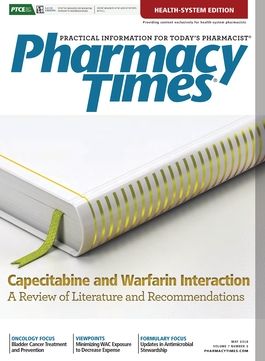Publication
Article
Pharmacy Practice in Focus: Health Systems
Capecitabine and Warfarin Interaction: A Review of Literature and Recommendations
The capecitabine and warfarin interaction is well documented in the literature and has earned a black box warning because of its potential severity.
The capecitabine and warfarin interaction is well documented in the literature and has earned a black box warning because of its potential severity.1Pharmacists are likely to observe this interaction, given the acceptance of anticoagulant use for venous thromboembolism (VTE) treatment and prophylaxis in patients with cancer. Because VTE is a common complication of malignant disorders and is associated with a lower survival rate in patients with cancer than in those without,2VTE prophylaxis has become the standard of care in the inpatient setting and often in the outpatient setting as well. Although unfractionated heparin and low-molecular-weight heparin (LMWH) are preferred agents for VTE treatment and prophylaxis in patients with malignancy, clinicians switch many patients to warfarin because of the cost and ease of administration. Warfarin notably interacts with numerous foods and drugs, including antineoplastics such as capecitabine. Thus, itis critical for pharmacists and other health care providers to be aware of this interaction to ensure effective and safe treatment of patients who require both agents.
Capecitabine is an oral prodrug of 5-fluorouracil (5-FU) that is indicated for breast, colon, and rectal cancers.1It is rapidly absorbed and undergoes a multistep enzymatic process before finally being converted into the active drug, 5-FU. The drug is then metabolized by normal and tumor cells to metabolites that cause cell injury and death. Warfarin is a vitamin K antagonist that blocks the synthesis of active vitamin K—dependent clotting factors II, VII, IX, and X and proteins C and S.3It consists of 2 enantiomers, (R) and (S), with (S)-enantiomer being 2 to 5 times more potent than (R)-enantiomer. (S)-enantiomer is exclusively metabolized by cytochrome P450 (CYP) 2C9, while (R)-enantiomer is metabolized by CYP1A2 and 3A4.
The proposed mechanism of the interaction between capecitabine and warfarin involves down-regulation of the CYP2C9 enzyme by capecitabine or its metabolites.4Given that capecitabine and its metabolites are less than 60% plasma protein bound, it is less likely that this is the cause of the pharmacokinetic (PK) interaction with warfarin (a highly protein-bound drug ~ 99%). Several case reports and postmarketing surveillance have shown that prothrombin time (PT) and international normalized ratio (INR) in patients who were stable on anticoagulants were elevated several days to several months after introducing capecitabine and in one case after 2 months of stopping capecitabine.1,4
Results of a PK study5revealed that coadministration of capecitabine increased S-warfarin area under the curve (a measurement of drug bioavailability) and elimination half-life while decreasing clearance. Exposure to R-warfarin was not significantly affected. Conversely, plasma concentration of capecitabine and its metabolites were not affected by warfarin. Given that S-warfarin is exclusively metabolized by CYP2C9, it appears that capecitabine or its metabolites interact with warfarin via this enzyme subtype. The INR was significantly increased when capecitabine and warfarin were concurrently used. Factor VII levels also dropped in the presence of capecitabine, potentially increasing the risk of bleeding from warfarin. Several retrospective case series observed similar drug interaction between 5-FU and warfarin.6Given that capecitabine is converted to 5-FU, it is possible that an interaction with warfarin may occur via a similar mechanism.
To mitigate the risk of increased bleeding, patients receiving capecitabine and warfarin have their INR or prothrombin time monitored more frequently to adjust the warfarin dose accordingly.1Given that capecitabine is an oral antineoplastic agent used in the inpatient and outpatient settings, all pharmacists, regardless of their practice site, can play an important role in monitoring for this drug—drug interaction and intervening when necessary, as well as in educating patients and other health care practitioners about the benefits and risks of using warfarin over LMWH concurrently with antineoplastic agents.
Lloreta Kerliu is a PharmD candidate at the Massachusetts College of Pharmacy and Health Sciences School of Pharmacy in Boston. Jennifer D. Goldman, RPh, PharmD, FCCP, is a professor of pharmacy practice at the Massachusetts College of Pharmacy and Health Sciences School of Pharmacy.
References
- XELODA oral tablets, capecitabine oral tablets [prescribing information]. South San Francisco, CA: Genentech USA Inc; 2016. gene.com/download/pdf/xeloda_prescribing.pdf. Accessed March 29, 2018.
- Lee AY, Levine MN. Venous thromboembolism and cancer: risks and outcomes. Circulation.2003;107(23)(suppl 1):I17-I21.doi: 10.1161/01.CIR.0000078466.72504.AC.
- COUMADIN oral tablets, intravenous injection, warfarin sodium oral tablets, intravenous injection [prescribing information]. Princeton, NJ: Bristol-Myers Squibb Co; 2011. www.accessdata.fda.gov/drugsatfda_docs/label/2011/009218s107lbl.pdf. Accessed March 29, 2018.
- Giunta G. Adverse interaction between capecitabine and warfarin resulting in altered coagulation parameters: a review of the literature starting from a case report. Case Rep Med. 2010;2010:426804. doi:10.1155/2010/426804.
- Camidge R, Reigner B, Cassidy J, et al. Significant effect of capecitabine on the pharmacokinetics and pharmacodynamics of warfarin in patients with cancer. J Clin Oncol.2005;23(21):4719-4725. doi: 10.1200/JCO.2005.09.129.
- Brown MC. An adverse interaction between warfarin and 5-fluorouracil: a case report and review of the literature. Chemotherapy. 1999;45(5):392-395. doi: 10.1159/000007230.







